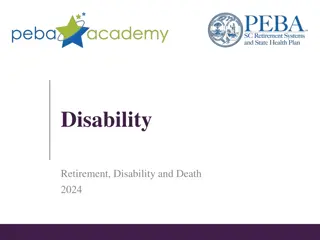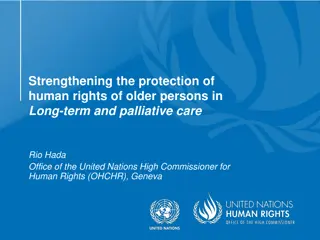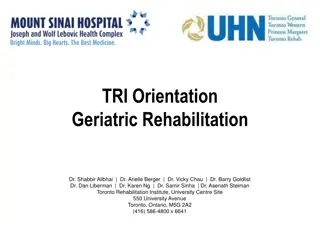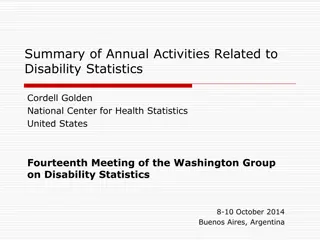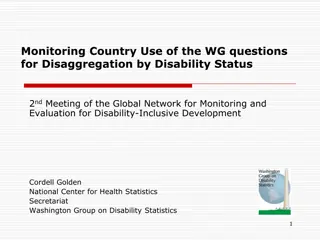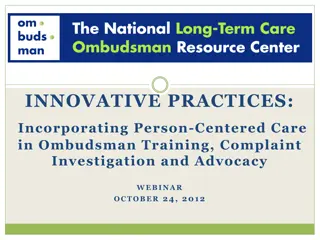Long-Term Care Needs and Disability Risk Analysis
Review the challenges and risks associated with long-term care needs, disability, and mortality compression as aging populations increase. Understand the differences between disability insurance and long-term care insurance, Medicaid benefits, and Medicare coverage for seniors. Explore the lifetime risk of developing a disability and the implications for caregiving and end-of-life planning.
Download Presentation

Please find below an Image/Link to download the presentation.
The content on the website is provided AS IS for your information and personal use only. It may not be sold, licensed, or shared on other websites without obtaining consent from the author.If you encounter any issues during the download, it is possible that the publisher has removed the file from their server.
You are allowed to download the files provided on this website for personal or commercial use, subject to the condition that they are used lawfully. All files are the property of their respective owners.
The content on the website is provided AS IS for your information and personal use only. It may not be sold, licensed, or shared on other websites without obtaining consent from the author.
E N D
Presentation Transcript
John John Amson Amson Capitman Capitman, PhD. , PhD. Nickerson Professor of Health Policy Central Valley Health Policy Institute California State University, Fresno
Day 2: Review of worksheets from Day 1 Anticipating Long-term Care Needs Caring for Caregivers Living Will: the 5 wishes Long-term Care Insurance
D-I-Y Obituary Anything learned or relearned Any new questions Recipes for a good death--- medical consensus Anything learned or relearned Any new questions
Compression of Mortality? Morbidity? Because of epidemiological transition, more people live to old age, and more people live to the natural limits of human life ===Smaller part of life course associated with most deaths====Compression of Mortality BUT is there a compression of morbidity? Later onset of disability?
Lifetime Risk of Disability Risk of current disability increases with age: for a person aged 85 (35 %) is more than 7x greater than for a person aged 74 (4.6 %). The lifetime risk of developing a disability in at least two primary activities of daily living for at least 3 months or becoming cognitively impaired is 44% for males and 72% for females at age 65. Women face a 64% higher risk than do men. Lifetime risk of developing a disability declines slightly with age. Lifetime Risk of Disability
1. Disability insurance and long term care (LTC) insurance cover the same things. 2. The average lifetime chance of needing long term care for an individual 65 years or older is more than 40%. 3. People have to spend all or almost all of their assets to get Medicaid benefits. 4. Medicare is not the primary funding source for most seniors long term care costs. 5. Most long term care is provided in a nursing home. 6. Medicaid covers long term care services received at home. 7. Nursing home expenses for Alzheimer s Disease patients are covered by Medicare. 8. The average length of stay in a nursing home is more than four years. 9. Nearly 40% of the long term care population is under the age of 65. 10. On average, a one 1. Disability insurance and long term care (LTC) insurance cover the same things. 2. The average lifetime chance of needing long term care for an individual 65 years or older is more than 40%. 3. People have to spend all or almost all of their assets to get Medicaid benefits. 4. Medicare is not the primary funding source for most seniors long term care costs. 5. Most long term care is provided in a nursing home. 6. Medicaid covers long term care services received at home. 7. Nursing home expenses for Alzheimer s Disease patients are covered by Medicare. 8. The average length of stay in a nursing home is more than four years. 9. Nearly 40% of the long term care population is under the age of 65. 10. On average, a one- -year stay in a nursing home costs about $30,000. year stay in a nursing home costs about $30,000.
Over 7 million Americans provide 120 million hours of informal care to approximately 4.2 million severely disabled elders each and every week. About 38 million adult caregivers (age 18 or older) provided unpaid care for ADL/IADL Caregivers provided an average of 21 hours of care per week, or 1,080 hours per year. An estimated $350 billion/year to replace informal Out income, lost productivity, costs associated with health effects Over 7 million Americans provide 120 million hours of informal care to approximately 4.2 million severely disabled elders each and every week. About 38 million adult caregivers (age 18 or older) provided unpaid care for ADL/IADL Caregivers provided an average of 21 hours of care per week, or 1,080 hours per year. An estimated $350 billion/year to replace informal caregiving Out- -of income, lost productivity, costs associated with health effects caregiving of- -pocket, lost wages, lost retirement pocket, lost wages, lost retirement
If you are run down, tiring more than usual, will you be able to provide good care? If you have a cold or the flu, will your loved one catch it from you? If you become depressed will you be able to make good decisions, will life become unbearable? If you are not well, who will fill your shoes, whether temporarily or permanently? If you are run down, tiring more than usual, will you be able to provide good care? If you have a cold or the flu, will your loved one catch it from you? If you become depressed will you be able to make good decisions, will life become unbearable? If you are not well, who will fill your shoes, whether temporarily or permanently? BASIC TIPS Take a daily vitamin supplement Get exercise being. Get regular check Take a break from Watch for signs of depression Stay involved in hobbies Laugh with a friend Take a daily vitamin supplement Get exercise being. Get regular check- -ups and do not ignore possible symptoms of ill health. Take a break from caregiving Watch for signs of depression more information Stay involved in hobbies Laugh with a friend make it a priority for both your mental and physical well make it a priority for both your mental and physical well- - ups and do not ignore possible symptoms of ill health. caregiving respite time is crucial. more information respite time is crucial.
Educate how it may affect his or her behavior, pain level, etc. Find neighbors, church/synagogue, workplace, Area Agency on Aging or other organizations. Keep looking! Protect you need to get done. Try to find time for exercise, eating well and sleeping enough. Watch sleeping more or less than usual, increased or decreased appetite or lack of interest in usual activities). Notify your doctor if symptoms of depression are present. Consider ends. Educate yourself about the disease your family member is facing and Find sources of help for caregiver tasks. Contact family, friends, Protect your personal time for something you enjoy or something Watch out for symptoms of depression (such as crying more, Consider how you will feel and what you will do after the caregiving
In-home supports (home health, homemaker, independent living aide) Out-of-home, community care (adult day care, outpatient rehabilitation) Supportive/Transitional Housing Board and care Assisted living CCRC Nursing homes
Figure up to $150k in long-term care costs if needed for average time/mix of in-home and facility 3 primary options 1. Save money dedicated savings 2. Prepare to qualify for MediCal 3. Purchase LTC Insurance



